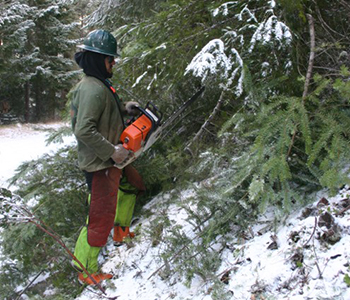Musculoskeletal
Fishing Safety
Commercial Fishing Safety

Forestry Services

Forestry services work occurs nationwide, yet is often hidden from the public eye.
Partnership for Dairy Safety and Health
Projects | Partnership | Motivation | Research | Contact | Dairy Safety Toolkit
We are excited to share our 'Partnership for Dairy Safety and Health' video that was released at the 2019 Washington Dairy Conference. Dairy owners and managers: please consider partnering with us in this work!
Ergonomic Evaluation of Emerging Mobile Platform Technologies in the Tree Fruit Industry
Tree-fruit activities such as pruning, structural cutting, and green fruit thinning, are high-intensity labor activities traditionally performed on the ground or on ladders. To explore the impact of new technology on worker strain and injury, this project conducted a comparison between three different treatment groups: ground, ladder, and harvest-assisted mobile platforms.
Total Worker Health in Salmon Fishermen from Cordova, Alaska
Reducing Workloads for Older Loggers in Physically Demanding Logging Tasks with Synthetic Rope
In the US, logging is among the top three most dangerous jobs, and when all factors are considered, logging is likely the most dangerous job and the most exertive work. Data in OR, WA, and ID show that 50% of loggers are at least 45 years old - and that percentage is growing. This pilot project assessed the ergonomic and economic benefits of using synthetic rope to replace wire rope in standardized logging tasks for older workers (>age 40) compared to current practices and younger workers.
Vibration and Noise Exposure in Forestry Workers
Workers in the forest industry are exposed to a number of sources of hand-arm and whole-body vibration, including a variety of hand tools and heavy equipment. Vibration exposure in forestry workers has been associated with negative health effects such as hand-arm vibration syndrome (HAVS) in several countries. The development of HAVS, or any of the ailments it encompasses, can force workers out of their employment by preventing them from performing their normal job tasks.
